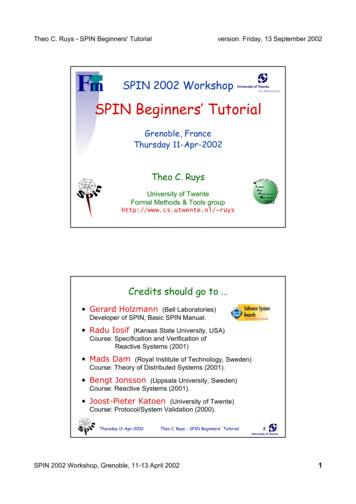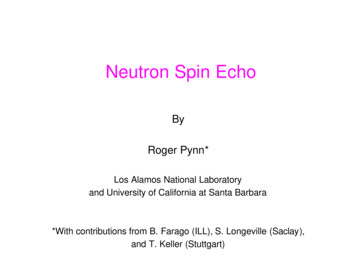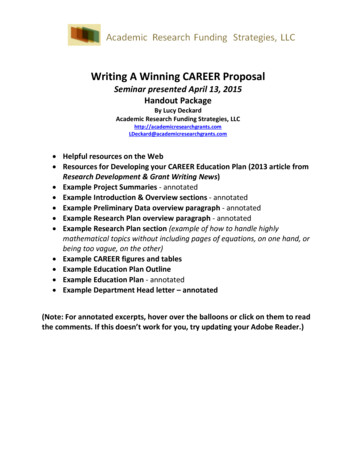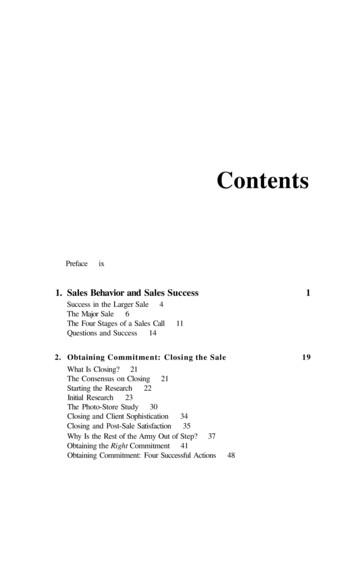
Transcription
Theo C. Ruys - SPIN Beginners' Tutorialversion: Friday, 13 September 2002SPIN 2002 WorkshopSPIN Beginners’ TutorialGrenoble, FranceThursday 11-Apr-2002Theo C. RuysUniversity of TwenteFormal Methods & Tools grouphttp://www.cs.utwente.nl/ ruysCredits should go to Gerard Holzmann (Bell Laboratories)Developer of SPIN, Basic SPIN Manual. Radu Iosif (Kansas State University, USA)Course: Specification and Verification ofReactive Systems (2001) Mads Dam (Royal Institute of Technology, Sweden)Course: Theory of Distributed Systems (2001). Bengt Jonsson (Uppsala University, Sweden)Course: Reactive Systems (2001). Joost-Pieter Katoen (University of Twente)Course: Protocol/System Validation (2000).Thursday 11-Apr-2002Theo C. Ruys - SPIN Beginners' TutorialSPIN 2002 Workshop, Grenoble, 11-13 April 200221
Theo C. Ruys - SPIN Beginners' Tutorialversion: Friday, 13 September 2002Audience & Contents Basic SPINintended audience:people totally new to (model checking and) SPIN Advanced SPINintended audience:people at least at the level of “Basic SPIN” ContentsEmphasis is on “using SPIN” not on technical details.In fact, we almost regard SPIN as a black box.We just want to“press-the-button”.Thursday 11-Apr-2002Theo C. Ruys - SPIN Beginners' Tutorial3Common Design Flaws DeadlockIn designing distributed systems:network applications,data communication protocols,multithreaded code,client-server applications. Livelock, starvation Underspecification– unexpected receptionof messages Overspecification– Dead code Violations of constraints– Buffer overruns– Array bounds violations Assumptions about speed– Logical correctness vs.real-time performanceThursday 11-Apr-2002Designing concurrent (software)systems is so hard, that theseflaws are mostly overlooked.Fortunately, most of thesedesign errors can be detectedusing model checking techniques!Theo C. Ruys - SPIN Beginners' TutorialSPIN 2002 Workshop, Grenoble, 11-13 April 200242
Theo C. Ruys - SPIN Beginners' Tutorialversion: Friday, 13 September 2002What is Model Checking? [Clarke & Emerson 1981]:“Model checking is an automated technique that, givena finite-state model of a system and a logical property,systematically checks whether this property holds for(a given initial state in) that model.” Model checking tools automatically verify whetherM φholds, where M is a (finite-state) model of a system andproperty φ is stated in some formal notation. Problem: state space explosion! SPIN [Holzmann 1991] is one ofthe most powerful model checkers.Although finite-state, themodel of a system typicallygrows exponentially.Based on [Vardi & Wolper 1986].Thursday 11-Apr-2002Theo C. Ruys - SPIN Beginners' Tutorial5System DevelopmentSystemEngineering“Classic”Model CheckingAnalysisDesign“Modern”Model CheckingCodeTestingClassic “waterfall model”[Pressman 1996]Thursday 11-Apr-2002MaintenanceTheo C. Ruys - SPIN Beginners' TutorialSPIN 2002 Workshop, Grenoble, 11-13 April 200263
Theo C. Ruys - SPIN Beginners' Tutorialversion: Friday, 13 September 2002“Classic” Model Checking(initial) Design(manual)abstractionsAbstractVerification nThursday 11-Apr-2002Theo C. Ruys - SPIN Beginners' Tutorial7“Modern” Model uesVerification ModelModelChecker Abstraction is the key activity in both approaches. This talk deals with pure SPIN, i.e., the “classic”model checking approach.To cope with thestate space explosion.Thursday 11-Apr-2002Theo C. Ruys - SPIN Beginners' TutorialSPIN 2002 Workshop, Grenoble, 11-13 April 200284
Theo C. Ruys - SPIN Beginners' Tutorialversion: Friday, 13 September 2002Verification vs. Debugging Two (extreme) approaches with respect to theapplication of model checkers.– verification approach: tries to ascertain the correctnessof a detailed model M of the system under validation.– debugging approach: tries to find errors in a model M. Model checking is most effective in combination withthe debugging approach.Automatic verification is not about provingcorrectness, but about finding bugs muchearlier in the development of a system.Thursday 11-Apr-2002Theo C. Ruys - SPIN Beginners' Tutorial9Program suggestions Some presentations at ETAPS/SPIN 2002 somehowrelated to this tutorial:– Dennis DamsAbstraction in Software Model Checking Friday April 12th 10.45-13.00– John Hatcliff, Matthew Dwyer and Willem VisserUsing the Bandera Tool Set and JPF (Tutorial 10) Saturday April 13th (full day)– SPIN Applications Saturday April 13th 11.00-12.30“Modern” model checking approach.Thursday 11-Apr-2002Theo C. Ruys - SPIN Beginners' TutorialSPIN 2002 Workshop, Grenoble, 11-13 April 2002105
Theo C. Ruys - SPIN Beginners' Tutorialversion: Friday, 13 September 2002Basic SPIN Gentle introduction to SPIN and Promela– SPIN Background– Promela processes– Promela statements– Promela communication primitives– Architecture of (X)Spin– Some demo’s: SPIN and Xspin hello worldWindows 2000: OK, but mutual exclusionSPIN runs more smoothly alternating bit protocolunder Unix/Linux.– Cookie for the breakThursday 11-Apr-2002Theo C. Ruys - SPIN Beginners' TutorialSPIN - Introduction11(1) SPIN ( Simple Promela Interpreter) is a tool for analysing the logical conisistency of concurrentsystems, specifically of data communication protocols. state-of-the-art model checker, used by 2000 users– Concurrent systems are described in the modellinglanguage called Promela. Promela ( Protocol/Process Meta Language)– allows for the dynamic creation of concurrent processes.– communication via message channels can be defined to be synchronous (i.e. rendezvous), or asynchronous (i.e. buffered). featuresfrom CSP– resembles the programming language C– specification language to model finite-state systemsThursday 11-Apr-2002Theo C. Ruys - SPIN Beginners' TutorialSPIN 2002 Workshop, Grenoble, 11-13 April 2002126
Theo C. Ruys - SPIN Beginners' Tutorialversion: Friday, 13 September 2002SPIN - Introduction(2) Major versions:1.02.03.04.0Jan 1991Jan 1995Apr 1997late 2002initial version [Holzmann 1991]partial order reductionminimised automaton representationAx: automata extraction from C code Some success factors of SPIN (subjective!):–––––“press on the button” verification (model checker)very efficient implementation (using C)nice graphical user interface (Xspin)not just a research tool, but well supportedcontains more than two decades research on advancedcomputer aided verification (many optimization algorithms)Thursday 11-Apr-2002Theo C. Ruys - SPIN Beginners' Tutorial13Documentation on SPIN SPIN’s starting spin.html––––––Basic SPIN manualAlso part of SPIN’sGetting started with Xspindocumentation distributionGetting started with SPIN(file: html.tar.gz)Examples and ExercisesConcise Promela Reference (by Rob Gerth)Proceedings of all SPIN Workshops Gerard Holzmann’s website for papers on SPIN:http://cm.bell-labs.com/cm/cs/who/gerard/ SPIN version 1.0 is described in [Holzmann 1991].Thursday 11-Apr-2002Theo C. Ruys - SPIN Beginners' TutorialSPIN 2002 Workshop, Grenoble, 11-13 April 2002147
Theo C. Ruys - SPIN Beginners' Tutorialversion: Friday, 13 September 2002Promela Model Promela model consist of:–––––type declarationschannel declarationsvariable declarationsprocess declarations[init process]proctype Sender() {.process body} A Promela model correspondswith a (usually very large, but)finite transition system, so––––no unbounded datano unbounded channelsno unbounded processesno unbounded process creationThursday 11-Apr-2002mtype {MSG, ACK};chan toS .chan toR .bool flag;proctype Receiver() {.}init {.}creates processesTheo C. Ruys - SPIN Beginners' TutorialProcesses15(1) A process type (proctype) consist of––––a namea list of formal parameterslocal variable declarationsbodynameformal parametersproctype Sender(chan in; chan out) {bit sndB, rcvB;local variablesdo:: out ! MSG, sndB - in ? ACK, rcvB;ifbody:: sndB rcvB - sndB 1-sndB:: else - skipfiThe body consist of aodsequence of statements.}Thursday 11-Apr-2002Theo C. Ruys - SPIN Beginners' TutorialSPIN 2002 Workshop, Grenoble, 11-13 April 2002168
Theo C. Ruys - SPIN Beginners' Tutorialversion: Friday, 13 September 2002Processes(2) A process– is defined by a proctype definition– executes concurrently with all other processes,independent of speed of behaviour– communicate with other processes using global (shared) variables using channels There may be several processes of the same type. Each process has its own local state:– process counter (location within the proctype)– contents of the local variablesThursday 11-Apr-2002Theo C. Ruys - SPIN Beginners' TutorialProcesses Process are created usingthe run statement (whichreturns the process id). Processes can be createdat any point in the execution(within any process). Processes start executingafter the run statement. Processes can also becreated by adding activein front of the proctypedeclaration.Thursday 11-Apr-2002(3)proctype Foo(byte x) {.}init {int pid2 run Foo(2);run Foo(27);}number of procs. (opt.)active[3] proctype Bar() {.}parameters will beinitialised to 0Theo C. Ruys - SPIN Beginners' TutorialSPIN 2002 Workshop, Grenoble, 11-13 April 200217189
Theo C. Ruys - SPIN Beginners' TutorialDEMOversion: Friday, 13 September 2002Hello World!/* A "Hello World" Promela model for SPIN. */active proctype Hello() {printf("Hello process, my pid is: %d\n", pid);}init {int lastpid;printf("init process, my pid is: %d\n", pid);lastpid run Hello();printf("last pid was: %d\n", lastpid);}random seed spin -n2 hello.prrunning SPIN ininit process, my pid is: 1random simulation modelast pid was: 2Hello process, my pid is: 0Hello process, my pid is: 23 processes createdThursday 11-Apr-2002Theo C. Ruys - SPIN Beginners' TutorialVariables and Types19(1)Basic types Five different (integer)basic types.bitboolbyteshortint Arrays Records (structs)[0.1][0.1][0.255][-216-1. 216 –1][-232-1. 232 –1]turn 1;flag;counter;s;msg;Arrays Type conflicts are detectedat runtime.arrayindicingstart at 0byte a[27];bit flags[4]; Default initial value of basic Typedef (records)typedef Recordvariables (local and global)short f1;byte f2;is 0.{}Record rr;rr.f1 .Thursday 11-Apr-2002Theo C. Ruys - SPIN Beginners' TutorialSPIN 2002 Workshop, Grenoble, 11-13 April 2002variabledeclaration2010
Theo C. Ruys - SPIN Beginners' Tutorialversion: Friday, 13 September 2002Variables and Typesint ii;bit bb; Variables should bedeclared. Variables can be given avalue by:– assignment– argument passing– message passing(see communication) Variables can be used inexpressions.Most arithmetic, relational,and logical operators ofC/Java are supported,including bitshift operators.Thursday 11-Apr-2002(2)assignment bb 1;ii 2;short s -1;typedef Foo {bit bb;int ii;};Foo f;f.bb 0;f.ii -2;declaration initialisationequal test ii*s 27 23;printf(“value: %d”, s*s);Theo C. Ruys - SPIN Beginners' TutorialStatements21(1) The body of a process consists of a sequence ofstatements. A statement is eitherexecutable/blockeddepends on the global– executable: the statement canstate of the system.be executed immediately.– blocked: the statement cannot be executed. An assignment is always executable. An expression is also a statement; it is executable if itevaluates to non-zero.2 3x 273 xThursday 11-Apr-2002always executableonly executable if value of x is smaller 27executable if x is not equal to –3Theo C. Ruys - SPIN Beginners' TutorialSPIN 2002 Workshop, Grenoble, 11-13 April 20022211
Theo C. Ruys - SPIN Beginners' Tutorialversion: Friday, 13 September 2002Statements(2)Statements areseparated by asemi-colon: “;”. The skip statement is always executable.– “does nothing”, only changes process’ process counter A run statement is only executable if a new process can becreated (remember: the number of processes is bounded). A printf statement is always executable (but is notevaluated during verification, of course).int x;proctype Aap(){int y 1;skip;run Noot();x 2;x 2 && y 1;skip;}Thursday 11-Apr-2002Executable if Noot canbe created Can only become executableif a some other processmakes x greater than 2.Theo C. Ruys - SPIN Beginners' TutorialStatements23(3) assert( expr );– The assert-statement is always executable.– If expr evaluates to zero, SPIN will exit with an error, asthe expr “has been violated”.– The assert-statement is often used within Promela models,to check whether certain properties are valid in a state.proctype monitor() {assert(n 3);}proctype receiver() {.toReceiver ? msg;assert(msg ! ERROR);.}Thursday 11-Apr-2002Theo C. Ruys - SPIN Beginners' TutorialSPIN 2002 Workshop, Grenoble, 11-13 April 20022412
Theo C. Ruys - SPIN Beginners' Tutorialversion: Friday, 13 September 2002Interleaving Semantics Promela processes execute concurrently. Non-deterministic scheduling of the processes. Processes are interleaved (statements of differentprocesses do not occur at the same time).– exception: rendez-vous communication. All statements are atomic; each statement is executedwithout interleaving with other processes. Each process may have several different possible actionsenabled at each point of execution.– only one choice is made, non-deterministically. randomlyThursday 11-Apr-2002 deadlocks safety properties liveness propertiesTheo C. Ruys - SPIN Beginners' Tutorial(X)SPIN ArchitectureSPINϕ25M melamodel MXspinediting windowsimulation optionsverification optionsMSC simulation windowThursday 11-Apr-2002spin.exeVerifierGeneratorC programcounterexamplefalsecheckerpan.exe Theo C. Ruys - SPIN Beginners' TutorialSPIN 2002 Workshop, Grenoble, 11-13 April 2002pan.*2613
Theo C. Ruys - SPIN Beginners' Tutorialversion: Friday, 13 September 2002Xspin in a nutshell Xspin allows the user to– edit Promela models ( syntax check)– simulate Promela models random interactive guided– verify Promela models exhaustive bitstate hashing modewith dialog boxes to setvarious options and directivesto tune the verification process– additional features Xspin suggest abstractions to a Promela model (slicing)Xspin can draw automata for each processLTL property managerHelp system (with verification/simulation guidelines)Thursday 11-Apr-2002DEMOTheo C. Ruys - SPIN Beginners' TutorialMutual Exclusionbit flag;byte mutex;27WRONG!(1)/* signal entering/leaving the section *//* # procs in the critical section.*/proctype P(bit i) {flag ! 1;models:flag 1;while (flag 1) /* wait */;mutex ;printf("MSC: P(%d) has entered section.\n", i);mutex--;flag 0;Problem: assertion violation!}Both processes can pass theproctype monitor() {flag ! 1 “at the same time”,assert(mutex ! 2);i.e. before flag is set to 1.}init {atomic { run P(0); run P(1); run monitor(); }}starts two instances of process PThursday 11-Apr-2002Theo C. Ruys - SPIN Beginners' TutorialSPIN 2002 Workshop, Grenoble, 11-13 April 20022814
Theo C. Ruys - SPIN Beginners' TutorialDEMOversion: Friday, 13 September 2002Mutual Exclusionbit x, y;byte mutex;WRONG!(2)/* signal entering/leaving the section/* # of procs in the critical section.*/*/active proctype B() {y 1;x 0;mutex ;mutex--;y 0;}active proctype A() {x 1;Process A waits fory 0;process B to end.mutex ;mutex--;x 0;}active proctype monitor() {assert(mutex ! 2);}Problem: invalid-end-state!Both processes can pass executex 1 and y 1 “at the same time”,and will then be waiting for each other.Thursday 11-Apr-2002DEMOTheo C. Ruys - SPIN Beginners' TutorialMutual Exclusionbit x, y;byte mutex;byte turn;29Dekker [1962](3)/* signal entering/leaving the section/* # of procs in the critical section./* who's turn is it?active proctype A() {x 1;turn B TURN;y 0 (turn A TURN);mutex ;mutex--;Can be generalisedx 0;to a single process.}active proctype monitor() {assert(mutex ! 2);}Thursday 11-Apr-2002*/*/*/active proctype B() {y 1;turn A TURN;x 0 (turn B TURN);mutex ;mutex--;y 0;}First “software-only” solution to themutex problem (for two processes).Theo C. Ruys - SPIN Beginners' TutorialSPIN 2002 Workshop, Grenoble, 11-13 April 20023015
Theo C. Ruys - SPIN Beginners' TutorialDEMOversion: Friday, 13 September 2002Mutual Exclusionbyte turn[2];byte mutex;Bakery(4)/* who’s turn is it?*//* # procs in critical section */proctype P(bit i) {Problem (in Promela/SPIN):doturn[i] will overrun after 255.:: turn[i] 1;turn[i] turn[1-i] 1;(turn[1-i] 0) (turn[i] turn[1-i]);mutex ;mutex--;turn[i] 0;More mutual exclusion algorithmsodin (good-old) [Ben-Ari 1990].}proctype monitor() { assert(mutex ! 2); }init { atomic {run P(0); run P(1); run monitor()}}Thursday 11-Apr-2002Theo C. Ruys - SPIN Beginners' Tutorialif-statement(1)31inspired by:Dijkstra’s guardedcommand languageif:: choice1 - stat1.1; stat1.2; stat1.3; :: choice2 - stat2.1; stat2.2; stat2.3; :: :: choicen - statn.1; statn.2; statn.3; fi; If there is at least one choicei (guard) executable, the ifstatement is executable and SPIN non-deterministicallychooses one of the executable choices. If no choicei is executable, the if-statement is blocked. The operator “- ” is equivalent to “;”. By convention, it is usedwithin if-statements to separate the guards from thestatements that follow the guards.Thursday 11-Apr-2002Theo C. Ruys - SPIN Beginners' TutorialSPIN 2002 Workshop, Grenoble, 11-13 April 20023216
Theo C. Ruys - SPIN Beginners' Tutorialversion: Friday, 13 September 2002if-statementif::::::::fi(n % 2 ! 0) - n 1(n 0)- n n-2(n % 3 0) - n 3else- skipskipskipskipskip- - - - The else guard becomesexecutable if none of theother guards is executable.non-deterministic branchinggive n a random valueif::::::::fi(2)n 0n 1n 2n 3skips are redundant, because assignmentsare themselves always executable.Thursday 11-Apr-2002Theo C. Ruys - SPIN Beginners' Tutorialdo-statement33(1)do:: choice1 - stat1.1; stat1.2; stat1.3; :: choice2 - stat2.1; stat2.2; stat2.3; :: :: choicen - statn.1; statn.2; statn.3; od; With respect to the choices, a do-statement behaves in thesame way as an if-statement. However, instead of ending the statement at the end of thechoosen list of statements, a do-statement repeats the choiceselection. The (always executable) break statement exits a do-loopstatement and transfers control to the end of the loop.Thursday 11-Apr-2002Theo C. Ruys - SPIN Beginners' TutorialSPIN 2002 Workshop, Grenoble, 11-13 April 20023417
Theo C. Ruys - SPIN Beginners' Tutorialversion: Friday, 13 September 2002do-statement(2)if- and do-statementsare ordinary Promelastatements; so they canbe nested. Example – modelling a traffic lightmtype { RED, YELLOW, GREEN } ;mtype (message type) models enumerations in Promelaactive proctype TrafficLight() {byte state GREEN;do:: (state GREEN) - state YELLOW;:: (state YELLOW) - state RED;:: (state RED)- state GREEN;od;}Note: this do-loop does not containany non-deterministic choice.Thursday 11-Apr-2002Theo C. Ruys - SPIN Beginners' MSGMSGs2r?MSGACKr2s!ACKr2s?ACK! is sending? is receivingThursday 11-Apr-2002Theo C. Ruys - SPIN Beginners' TutorialSPIN 2002 Workshop, Grenoble, 11-13 April 20023618
Theo C. Ruys - SPIN Beginners' Tutorialversion: Friday, 13 September 2002Communication(2) Communication between processes is via channels:– message passing– rendez-vous synchronisation (handshake)also called:queue or buffer Both are defined as channels:chan name [ dim ] of { t1 , t2 , tn };name ofthe channeltype of the elements that will betransmitted over the channelnumber of elements in the channeldim 0 is special case: rendez-vouschan c [1] of {bit};chan toR [2] of {mtype, bit};chan line[2] [1] of {mtype, Record};Thursday 11-Apr-2002array ofchannelsTheo C. Ruys - SPIN Beginners' TutorialCommunication37(3) channel FIFO-buffer (for dim 0)!Sending - putting a message into a channelch ! expr1 , expr2 , exprn ; The values of expri should correspond with the types of thechannel declaration. A send-statement is executable if the channel is not full.? Receiving - getting a message out of a channelch ? var1 , var2 , varn ; var const can bemixedmessage passing If the channel is not empty, the message is fetched from the channeland the individual parts of the message are stored into the vari s.ch ? const1 , const2 , constn ; message testing If the channel is not empty and the message at the front of thechannel evaluates to the individual consti , the statement isexecutable and the message is removed from the channel.Thursday 11-Apr-2002Theo C. Ruys - SPIN Beginners' TutorialSPIN 2002 Workshop, Grenoble, 11-13 April 20023819
Theo C. Ruys - SPIN Beginners' Tutorialversion: Friday, 13 September 2002Communication(4) Rendez-vous communication dim 0The number of elements in the channel is now zero.– If send ch! is enabled and if there is a correspondingreceive ch? that can be executed simultaneously and theconstants match, then both statements are enabled.– Both statements will “handshake” and togethertake the transition. Example:chan ch [0] of {bit, byte};– P wants to doch ! 1, 3 7– Q wants to doch ? 1, x– Then after the communication, x will have the value 10.Thursday 11-Apr-2002DEMOTheo C. Ruys - SPIN Beginners' TutorialAlternating Bit Protocol39(1) Alternating Bit Protocol– To every message, the sender adds a bit.– The receiver acknowledges each message by sendingthe received bit back.– To receiver only excepts messages with a bit that itexcepted to receive.– If the sender is sure that the receiver has correctlyreceived the previous message, it sends a newmessage and it alternates the accompanying bit.Thursday 11-Apr-2002Theo C. Ruys - SPIN Beginners' TutorialSPIN 2002 Workshop, Grenoble, 11-13 April 20024020
Theo C. Ruys - SPIN Beginners' TutorialDEMOversion: Friday, 13 September 2002Alternating Bit Protocolchannellength of 2chan toS [2] of {mtype, bit};chan toR [2] of {mtype, bit};proctype Receiver(chan in, out){bit recvbit;do:: in ? MSG(recvbit) - out ! ACK(recvbit);od}mtype {MSG, ACK};proctype Sender(chan in, out){bit sendbit, recvbit;do:: out ! MSG, sendbit - in ? ACK, recvbit;if:: recvbit sendbit - sendbit 1-sendbit:: elsefiod}Thursday 11-Apr-2002(2)init{run Sender(toS, toR);run Receiver(toR, toS);}Alternative notation:ch ! MSG(par1, )ch ? MSG(par1, )Theo C. Ruys - SPIN Beginners' Tutorial41[Ruys & Brinksma 1998]Cookie: “hippies” problemGermany.5.10.20 60 min?.Hollandholescoffeeshop25 2 persThursday 11-Apr-2002Theo C. Ruys - SPIN Beginners' TutorialSPIN 2002 Workshop, Grenoble, 11-13 April 20024221
Theo C. Ruys - SPIN Beginners' Tutorialversion: Friday, 13 September 2002[Ruys & Brinksma 1998]Cookie: soldiers problemunsafe5 60 min?safe10 20 25 2 persThursday 11-Apr-2002Theo C. Ruys - SPIN Beginners' Tutorial43Advanced SPIN Towards effective modelling in Promela– Some left-over Promela statements– Properties that can be verified with SPIN– Introduction to SPIN validation algorithms– SPIN’s reduction algorithms– Extreme modelling: the “art of modelling”– Beyond Xspin: managing the verification trajectory– Concluding remarks– SummaryThursday 11-Apr-2002Theo C. Ruys - SPIN Beginners' TutorialSPIN 2002 Workshop, Grenoble, 11-13 April 20024422
Theo C. Ruys - SPIN Beginners' Tutorialversion: Friday, 13 September 2002Basic SPINPromela Model A Promela model consist of:mtype, typedefs,constants– type declarationschan ch [dim] of {type, }asynchronous: dim 0rendez-vous: dim 0– channel declarations– global variable declarations– process declarations– [init process]can be accessedby all processesbehaviour of the processes:local variables statementsinitialises variables andstarts processesThursday 11-Apr-2002Theo C. Ruys - SPIN Beginners' TutorialPromela statementsalways executableskip45Basic SPINare either executableor blockedassert( expr ) always executableexpressionexecutable if not zeroassignmentalways executableifexecutable if at least one guard is executabledoexecutable if at least one guard is executablebreakalways executable (exits do-statement)send (ch!)executable if channel ch is not fullreceive (ch?)executable if channel ch is not emptyThursday 11-Apr-2002Theo C. Ruys - SPIN Beginners' TutorialSPIN 2002 Workshop, Grenoble, 11-13 April 20024623
Theo C. Ruys - SPIN Beginners' Tutorialversion: Friday, 13 September 2002atomicatomic { stat1; stat2; . statn }– can be used to group statements into an atomic sequence;all statements are executed in a single step(no interleaving with statements of other processes)no pure atomicity– is executable if stat1 is executable– if a stati (with i 1) is blocked, the “atomicity token” is(temporarily) lost and other processes may do a step (Hardware) solution to the mutual exclusion problem:proctype P(bit i) {atomic {flag ! 1; flag 1; }mutex ;mutex--;flag 0;}Thursday 11-Apr-2002Theo C. Ruys - SPIN Beginners' Tutorial47d stepd step { stat1; stat2; . statn }– more efficient version of atomic: no intermediate states aregenerated and stored– may only contain deterministic steps– it is a run-time error if stati (i 1) blocks.– d step is especiallyuseful to performintermediate computationsin a single transition::Rout?i(v) - d step {k ;e[k].ind i;e[k].val v;i 0; v 0 ;} atomic and d step can be used to lower the number ofstates of the modelThursday 11-Apr-2002Theo C. Ruys - SPIN Beginners' TutorialSPIN 2002 Workshop, Grenoble, 11-13 April 20024824
Theo C. Ruys - SPIN Beginners' Tutorialversion: Friday, 13 September 2002No atomicityproctype P1() { t1a; t1b; t1c }proctype P2() { t2a; t2b; t2c }init { run P1(); run P2() }P1P200t1at1a (0,1)t2bt1c (2,0) t2at1b (1,1)t2b t1a (0,2)(3,0)t2ct2a t1c (2,1)t2b t1b (1,2)t2c t1a (0,3)(3,1)t2b t1c (2,2)t2c t1b (1,3)(3,2)t2c t1c (2,3)1t1bt2b22t1ct2c3t2at1b (1,0) t2at2a1(0,0)t1a3(3,3)Not completely correct as eachprocess has an implicit end-transition Thursday 11-Apr-2002Theo C. Ruys - SPIN Beginners' Tutorialatomicproctype P1() { atomic {t1a; t1b; t1c} }proctype P2() { t2a; t2b; t2c }init { run P1(); run P2() }It is as if P1 has only one transition (2,2)(3,2)If one of P1’s transitionsblocks, these transitionsmay get executed(0,3)(1,3)(2,3)(3,3)Thursday 11-Apr-200249Although atomic clauses cannotbe interleaved, the intermediatestates are still constructed.Theo C. Ruys - SPIN Beginners' TutorialSPIN 2002 Workshop, Grenoble, 11-13 April 20025025
Theo C. Ruys - SPIN Beginners' Tutorialversion: Friday, 13 September 2002d stepproctype P1() { d step {t1a; t1b; t1c} }proctype P2() { t2a; t2b; t2c }init { run P1(); run P2() }It is as if P1 has only one transition (2,2)(3,2)(0,3)(1,3)(2,3)No intermediate states willbe constructed.(3,3)Thursday 11-Apr-2002Theo C. Ruys - SPIN Beginners' Tutorial51Checking for pure atomicity Suppose we want to check that none of the atomic clausesin our model are ever blocked (i.e. pure atomicity).1. Add a global bit variable:2. Change all atomic clauses to:atomic {stat1;bit aflag;aflag 1;stat23. Check that aflag is always 0.[]!aflage.g.active process monitor {assert(!aflag);}Thursday 11-Apr-2002statnaflag 0;}Theo C. Ruys - SPIN Beginners' TutorialSPIN 2002 Workshop, Grenoble, 11-13 April 20025226
Theo C. Ruys - SPIN Beginners' Tutorialversion: Friday, 13 September 2002timeout(1) Promela does not have real-time features.– In Promela we can only specify functional behaviour.– Most protocols, however, use timers or a timeoutmechanism to resend messages or acknowledgements. timeout– SPIN’s timeout becomes executable if there is noother process in the system which is executable– so, timeout models a global timeout– timeout provides an escape from deadlock states– beware of statements that are always executable Thursday 11-Apr-2002Theo C. Ruys - SPIN Beginners' Tutorialtimeout53(2) Example to recover from message loss:active proctype Receiver(){bit recvbit;do:: toR ? MSG, recvbit - toS ! ACK, recvbit;:: timeout- toS ! ACK, recvbit;od} Premature timeouts can be modelled by replacing thetimeout by skip (which is always executable).One might want to limit the number of prematuretimeouts (see [Ruys & Langerak 1997]).Thursday 11-Apr-2002Theo C. Ruys - SPIN Beginners' TutorialSPIN 2002 Workshop, Grenoble, 11-13 April 20025427
Theo C. Ruys - SPIN Beginners' TutorialDEMOversion: Friday, 13 September 2002Alternating Bit Protocol abp-1.pr– perfect lines abp-2.pr(3)How large should MAX besuch that we are sure thatthe ABP works correctly?onlythree!– stealing daemon (models lossy channels)– how do we know that the protocol works correctly? abp-3.pr– model different messages by a sequence number– assert that the protocol works correctly– how can we be sure that different messages are beingtransmitted?Thursday 11-Apr-2002Theo C. Ruys - SPIN Beginners' Tutorial55gotogoto label– transfers execution to label– each Promela statement might be labelled– quite useful in modelling communication protocolswait ack:Timeout modelled by a channel.if:: B?ACK - ab 1-ab ; goto success:: ChunkTimeout?SHAKE - if:: (rc MAX) - rc ; F!(i 1),(i n),ab,d[i];goto wait ack:: (rc MAX) - goto errorfifi ;Part of model of BRPThursday 11-Apr-2002Theo C. Ruys - SPIN Beginners' TutorialSPIN 2002 Workshop, Grenoble, 11-13 April 20025628
Theo C. Ruys - SPIN Beginners' Tutorialversion: Friday, 13 September 2002unless{ stats } unless { guard; stats }– Statements in stats are executed until the firststatement (guard) in the escape sequence becomesexecutable.– resembles exception handling in languages like Java– Example:proctype MicroProcessor() {{./* execute normal ins
Theo C. Ruys - SPIN Beginners' Tutorial version: Friday, 13 September 2002 SPIN 2002 Workshop, Grenoble, 11-13 April 2002 7 Thursday 11-Apr-2002 Theo C. Ruys - SPIN Beginners' Tutorial 13 SPIN - Introduction (2) Major versions: 4.0 late 2002 Ax: automata extraction from C code 3.0 Apr 1997 minimised automaton representation










